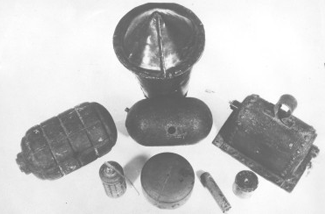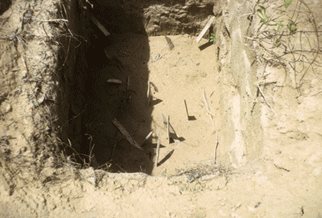CBS and the Defendants Battle Back
The lawyers for CBS also called a parade of witnesses of former government officials and military officers from the Vietnam War. In general, these witnesses were less senior than the ones who testified on Westmoreland’s behalf. In fact, in another example of courtroom theater, the defense  called two ordinary soldiers from the war to testify about the impact of booby-traps and mines set by irregular forces and the ease with which these devices could be made. For example, Army Reconnaissance Specialist Daniel Friedman, a decorated, twice-wounded combat veteran, testified that mines and booby traps were his unit’s “primary cause of concern.” He said that when his unit was on patrol, they would pass apparently friendly villages, but on their return would exchange fire with the enemy. According to Friedman, he and his fellow soldiers would later recognize the bodies of some of the enemies killed as “these same people that we saw waving to us on the side of the road.” Friedman said that he “saw too many of my buddies go down because of [mines and booby
called two ordinary soldiers from the war to testify about the impact of booby-traps and mines set by irregular forces and the ease with which these devices could be made. For example, Army Reconnaissance Specialist Daniel Friedman, a decorated, twice-wounded combat veteran, testified that mines and booby traps were his unit’s “primary cause of concern.” He said that when his unit was on patrol, they would pass apparently friendly villages, but on their return would exchange fire with the enemy. According to Friedman, he and his fellow soldiers would later recognize the bodies of some of the enemies killed as “these same people that we saw waving to us on the side of the road.” Friedman said that he “saw too many of my buddies go down because of [mines and booby  traps] not to be concerned about them.”1 He then took a fragmentation grenade and demonstrated to the jury how easy it was to set a booby trap. The testimony had brought the complex order of battle controversy down to the level of an ordinary soldier who had had to deal with the type of irregular forces Westmoreland had dismissed as inconsequential.
traps] not to be concerned about them.”1 He then took a fragmentation grenade and demonstrated to the jury how easy it was to set a booby trap. The testimony had brought the complex order of battle controversy down to the level of an ordinary soldier who had had to deal with the type of irregular forces Westmoreland had dismissed as inconsequential.
The Order of Battle Was “Fundamental”
Other officials testified specifically for the defense about the order of battle controversy. Among those testifying was George Allen, who had been the CIA’s number two official for Vietnamese affairs. Allen said that the “order of battle is fundamental to military intelligence. It’s your starting point for understanding the enemy force that’s confronting you in any kind of situation.” He said that in a war of attrition, a commander needs to know how many enemy troops he is facing in order to determine whether he is winning. Allen declared, “In Vietnam it [the order of battle] was not an academic exercise.”2 He asserted that the principal national security issue confronting Washington in 1966 and 1967 was whether the United States was winning the war of attrition in Vietnam, and a key component of that question was how many enemy troops were there. On this point, he specifically took issue with Westmoreland’s stated denigration of the importance of the order of battle.
Allen also maintained that the irregular militia forces had been included in the order of battle prior to 1967. “The guerrilla militia forces,” he testified “were …an integral part of the communist military force structure” in harassing and ambushing troops, terrorizing the populace, and supporting their own main force units. Allen said studies had estimated that self-defense militia forces inflicted as much as 40 percent of U.S. losses. The CIA official deplored what he called the “obvious shortcomings” of the order of battle.3
“Publication of that estimate was the mistake of the century.”CIA Official AllenAllen testified that he thought the new estimate “was essentially a dishonest piece of paper” that “was misleading in terms of the picture it made available to the policymakers.” Allen said that he told his colleague, analyst Sam Adams, that “publication of that estimate was the mistake of the century.” He said that he believed the CIA “had sold out” its “professional integrity” and “honesty” in going along with Westmoreland’s command in removing the militia forces from the calculations of enemy troops strength. He said that the new estimate “totally misrepresented the nature and scope of the enemy threat.”4 Allen testified that the new total was reported as being under 250,000, but that it should have been much higher to reflect the militia forces.
Westmoreland’s Chief of Intelligence Testifies
CIA analysts were not the only former officials to testify on behalf of CBS. Some members of General Westmoreland's staff also testified for the defense, including his chief of intelligence in 1967, General Joseph McChristian, who also argued for the importance of the order of battle. He explained that “[t]he intelligence officer must always keep in mind that he is responsible to provide timely, accurate, an adequate amount of the big picture, and usable intelligence on the enemy, so that all decision-makers…know the facts concerning the enemy, so that they may arrive at sound decisions.”5
McChristian testified that he thought, like Allen, that the militia members should have been included in the order of battle for much of the same reasons the CIA official cited: these militias were a key component of the enemy’s forces and they caused a significant number of American casualties. McChristian countered Westmoreland’s assertion that the militias did not matter because they were at the hamlet and village level, by saying, “from the point of view of the enemy, that was their real battleground.”6
“If I send that cable to Washington, it will create a political bombshell.”Westmoreland, According to McChristianMcChristian’s most important testimony regarded an encounter with General Westmoreland in early May 1967, when the intelligence chief brought a draft cable he intended to send to the Commander in Chief Pacific and the Joint Chiefs of Staff detailing greatly increased numbers of enemy forces in the order of battle. McChristian said that he was convinced that his staff was able “to collect adequate intelligence on the strength” of the militia forces “that increased the size of the intelligence figures . . . by a magnitude of almost two to one.” He further stated that this was a conservative estimate. He said that Westmoreland responded to the draft cable by saying, “If I send that cable to Washington, it will create a political bombshell.”7 McChristian offered his opinion that it was improper for a military officer to withhold a report based on political considerations.
_____________________________________________
1Trial transcript, 8713-4.
2Trial transcript, 7713.
3Trial transcript, 7715, 7723.
4Trial transcript, 7757-8.
5Trial transcript, 9003.
6Trial transcript, 9019.
7Trial transcript, 9027.